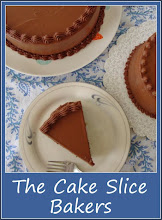 This month’s challenge was to make an authentic pizza dough that had been allowed to age and mature overnight. As an extra challenge this month our host Rosa from Rosa’s Yummy Yums, said we had to attempt to toss the dough in true Italian style!
This month’s challenge was to make an authentic pizza dough that had been allowed to age and mature overnight. As an extra challenge this month our host Rosa from Rosa’s Yummy Yums, said we had to attempt to toss the dough in true Italian style!Although we had to make an authentic pizza dough, our toppings were allowed to be as unauthentic and experimental as we pleased. So running with this freedom I chose to top my pizza with pureed apple for the sauce element and spinach, pumpkin, ricotta and walnuts for the toppings. Sounds a little crazy I know but I was thinking autumnal foods. Apple and pumpkin go together and so do the nuts. The ricotta works well with sweet and savoury flavours so that was in and the spinach, well it added a nice colour and it goes well with ricotta. No matter how strange the combo might sound it turned out to be a hit. I especially loved the apple ‘sauce’ – apple on a pizza who knew?!

I was also very impressed with the dough. It was a little sticky to work with at first but produced a great soft and stretchy dough. I froze most of my dough balls for future use but kept one in the fridge overnight to ferment and mature. I ended up leaving it for two nights and when I peeked at it after the two days it looked like it was trying to make a bid for freedom out of its bowl and was full of large air bubbles.
Tossing the dough was fun although I need to improve my technique as the middle ended up nice and thin but the edges stayed fat and puffy but I just squished it into place. Also, how do you produce a round pizza base? Mine always turn out oblong. I’m afraid the photos of me tossing the dough aren’t great, I was on my own and had to set balance the camera on the back of a chair and then try and catch the timer – but you get the idea.

I adored the flavour of this pizza base. Letting it mature really improved the flavour, it was almost like a sourdough, crisp brown crust, slightly chewy texture and full of air pockets. I had worried my apple topping would result in a soggy pizza base but it crisped up beautifully. All the toppings worked well together and when it came out of the oven I gave it a dusting of freshly grated nutmeg – essence of autumn on a plate.
Click here to view more daring bakers pizzas.
Pizza Dough
From “The Bread Baker’s Apprentice” by Peter Reinhart.
Makes 6 pizza crusts (about 9-12 inches/23-30 cm in diameter). Ingredients:
Ingredients:
 Ingredients:
Ingredients: 620g white bread flour
1¾ tsp Salt
1 tsp Instant yeast
60ml olive oil
420ml water, cold
1 tbsp sugar
Semolina or cornmeal for dusting
Method – Day One:
1. Mix together the flour, salt and instant yeast in a big bowl (or in the bowl of your stand mixer).
2. Add the oil, sugar and cold water and mix well (with the help of a large wooden spoon or with the paddle attachment, on low speed) in order to form a sticky ball of dough. On a clean surface, knead for about 5-7 minutes, until the dough is smooth and the ingredients are homogeneously distributed. If it is too wet, add a little flour (not too much, though) and if it is too dry add 1 or 2 teaspoons extra water.
NOTE: If you are using an electric mixer, switch to the dough hook and mix on medium speed for the same amount of time. The dough should clear the sides of the bowl but stick to the bottom of the bowl. If the dough is too wet, sprinkle in a little more flour, so that it clears the sides. If, on the contrary, it clears the bottom of the bowl, dribble in a teaspoon or two of cold water.The finished dough should be springy, elastic, and sticky, not just tacky, and register 50°-55° F/10°-13° C.
3. Flour a work surface or counter. Line a jelly pan with baking paper/parchment. Lightly oil the paper.
4. With the help of a metal or plastic dough scraper, cut the dough into 6 equal pieces (or larger if you want to make larger pizzas).
5. Sprinkle some flour over the dough. Make sure your hands are dry and then flour them. Gently round each piece into a ball.
6. Transfer the dough balls to the lined jelly pan and mist them generously with spray oil. Slip the pan into plastic bag or enclose in plastic food wrap.
7. Put the pan into the refrigerator and let the dough rest overnight or for up to thee days.
NOTE: You can store the dough balls in a zippered freezer bag if you want to save some of the dough for any future baking. In that case, pour some oil(a few tablespooons only) in a medium bowl and dip each dough ball into the oil, so that it is completely covered in oil. Then put each ball into a separate bag. Store the bags in the freezer for no longer than 3 months. The day before you plan to make pizza, remember to transfer the dough balls from the freezer to the refrigerator.
Day Two or After Proving: 8. On the day you plan to eat pizza, exactly 2 hours before you make it, remove the desired number of dough balls from the refrigerator. Dust the counter with flour and spray lightly with oil. Place the dough balls on a floured surface and sprinkle them with flour. Dust your hands with flour and delicately press the dough into disks about 1/2 inch/1.3 cm thick and 5 inches/12.7 cm in diameter. Sprinkle with flour and mist with oil. Loosely cover the dough rounds with plastic wrap and then allow to rest for 2 hours.
8. On the day you plan to eat pizza, exactly 2 hours before you make it, remove the desired number of dough balls from the refrigerator. Dust the counter with flour and spray lightly with oil. Place the dough balls on a floured surface and sprinkle them with flour. Dust your hands with flour and delicately press the dough into disks about 1/2 inch/1.3 cm thick and 5 inches/12.7 cm in diameter. Sprinkle with flour and mist with oil. Loosely cover the dough rounds with plastic wrap and then allow to rest for 2 hours.
 8. On the day you plan to eat pizza, exactly 2 hours before you make it, remove the desired number of dough balls from the refrigerator. Dust the counter with flour and spray lightly with oil. Place the dough balls on a floured surface and sprinkle them with flour. Dust your hands with flour and delicately press the dough into disks about 1/2 inch/1.3 cm thick and 5 inches/12.7 cm in diameter. Sprinkle with flour and mist with oil. Loosely cover the dough rounds with plastic wrap and then allow to rest for 2 hours.
8. On the day you plan to eat pizza, exactly 2 hours before you make it, remove the desired number of dough balls from the refrigerator. Dust the counter with flour and spray lightly with oil. Place the dough balls on a floured surface and sprinkle them with flour. Dust your hands with flour and delicately press the dough into disks about 1/2 inch/1.3 cm thick and 5 inches/12.7 cm in diameter. Sprinkle with flour and mist with oil. Loosely cover the dough rounds with plastic wrap and then allow to rest for 2 hours.9. At least 45 minutes before making the pizza, place a baking stone on the lower third of the oven. Preheat the oven as hot as possible (500° F/260° C).
NOTE: If you do not have a baking stone, then use the back of a jelly pan. Do not preheat the pan.
10. Generously sprinkle the back of a jelly pan with semolina/durum flour or cornmeal. Flour your hands (palms, backs and knuckles). Take 1 piece of dough by lifting it with a pastry scraper. Lay the dough across your fists in a very delicate way and carefully stretch it by bouncing it in a circular motion on your hands, and by giving it a little stretch with each bounce. Once the dough has expanded outward, move to a full toss.
NOTE: Make only one pizza at a time.During the tossing process, if the dough tends to stick to your hands, lay it down on the floured counter and re-flour your hands, then continue the tossing and shaping. In case you would be having trouble tossing the dough or if the dough never wants to expand and always springs back, let it rest for approximately 5-20 minutes in order for the gluten to relax fully, then try again.You can also resort to using a rolling pin, although it isn’t as effective as the toss method.
11. When the dough has the shape you want (about 9-12 inches/23-30 cm in diameter - for a 6 ounces/180g piece of dough), place it on the back of the jelly pan, making sure there is enough semolina/durum flour or cornmeal to allow it to slide and not stick to the pan.
12. Lightly top it with sweet or savory toppings of your choice.
13. Slide the garnished pizza onto the stone in the oven or bake directly on the jelly pan. Close the door and bake for about 5-8 minutes.
14. Take the pizza out of the oven and transfer it to a cutting board or your plate. In order to allow the cheese to set a little, wait 3-5 minutes before slicing or serving.
NOTE: After 2 minutes baking, take a peek. For an even baking, rotate 180°.
For my toppings
NOTE: After 2 minutes baking, take a peek. For an even baking, rotate 180°.
For my toppings
 1 large cooking apple
1 large cooking apple50g ricotta cheese
2 handfuls fresh spinach
25g walnuts
75g pumpkin or squash
Freshly grated nutmeg
Method
Peel and core the apple and cut into small cubes. Heat in a pan along with 1tbsp water until soft and mushy. Allow to simmer gently until thick. Taste and if very sharp add a little sugar to sweeten (but you don’t want it too sweet). Leave to cool.
Cut some slices out of the pumpkin and remove the skin. Cut into small dice sized pieces.
Wash the spinach in hot water to wilt it slightly and remove any dust or grit.
When ready to top the pizza spread the apple puree evenly over the surface of the dough leaving a 1inch gap around the edges.
Lay the spinach leaves over the top of the apple. Scatter over the pumpkin chunks and distribute dots of ricotta in-between.
Break the walnuts into pieces using your fingers and scatter over the top.
Bake as instructed. (My pizza took nearly 15 minutes but I suspect this was because the apple was quite wet, but the base was wonderfully crisp).
Makes enough topping for one large pizza.



 Ingredients
Ingredients



 Preheat the oven to 180C. Line the bottoms of three 8-inch round cake pans with parchment paper.
Preheat the oven to 180C. Line the bottoms of three 8-inch round cake pans with parchment paper. Place one cake layer flat side up on a cake stand or platter. Soak the cake with a third of the espresso syrup.
Place one cake layer flat side up on a cake stand or platter. Soak the cake with a third of the espresso syrup.


 Ingredients
Ingredients

 For the cake
For the cake 1 bag maltesers
1 bag maltesers Meanwhile make the fudge topping. Heat the milk and brown sugar together in a pan, stirring continuously until all the sugar has dissolved.
Meanwhile make the fudge topping. Heat the milk and brown sugar together in a pan, stirring continuously until all the sugar has dissolved. Find an outline of a tall straight candle and copy it many tiny on a piece of paper. Lay the paper onto a baking tray and over the surface with a layer of clingfilm, ensuring it lies smooth.
Find an outline of a tall straight candle and copy it many tiny on a piece of paper. Lay the paper onto a baking tray and over the surface with a layer of clingfilm, ensuring it lies smooth.


 For the sponge
For the sponge

 Ingredients
Ingredients




